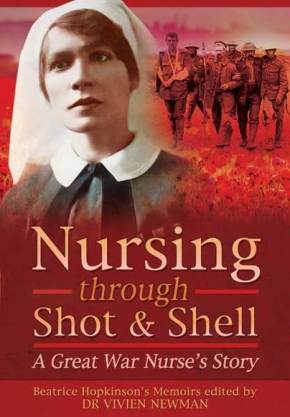Over the last year or so, I’ve developed a great interest in the role of women during the First World War and have read widely on the subject. The most interesting and informative b ooks are those based on personal memoir because it’s like looking into the past through a different window each time. Dr Vivien Newman’s latest book: Nursing Through Shot And Shell, A Great War Nurse’s Story, published by Pen and Sword Books is one such gem. Based on the previously unpublished memoirs of Beatrice Hopkinson, a member of the author’s family, Nursing Through Shot and Shell gives a vivid, and often uncompromising, account of what life was like for a member of the Territorial Forces Nursing Service (TFNS).
ooks are those based on personal memoir because it’s like looking into the past through a different window each time. Dr Vivien Newman’s latest book: Nursing Through Shot And Shell, A Great War Nurse’s Story, published by Pen and Sword Books is one such gem. Based on the previously unpublished memoirs of Beatrice Hopkinson, a member of the author’s family, Nursing Through Shot and Shell gives a vivid, and often uncompromising, account of what life was like for a member of the Territorial Forces Nursing Service (TFNS).
In the first section of the book, Newman provides the reader with historical background to Beatrice’s diary and this section really is invaluable. Newman’s research is impeccable and her concise, informative style gives readers all the context necessary about Beatrice, her background and nursing during wartime. By the time I started on Beatrice’s diary, I knew enough about her world to become quickly immersed in her recollections.
Despite having read several other memoirs and narratives on nursing during the Great War, I discovered perspectives and experiences here that I haven’t come across before. For example, while stationed in France, Beatrice belonged to an elite group of nurses who were effectively ‘rapid response’ teams. These six person teams would be sent out to provide support where needed, usually at Casualty Clearing Stations close to the front line. Their life was demanding, arduous and often dangerous; only the most competent and skilled nurses were selected. Beatrice’s account of this time are gripping and revelatory.
Another perspective we don’t often get is what life was like as the war
came to an end. During the closing weeks of the war, the German front lines were being pushed further back and inevitably, as allied forces advanced, so the nursing teams moved with them. This meant that Beatrice found herself in the middle of newly abandoned battlefields which had, just a week or so earlier, been the scene of some of the fiercest fighting of the war. She was faced with desolation on an apocalyptic scale – a land of water-filled craters, deserted trenches and acres of barbed wire. Towns and villages reduced to little more than the sign that marked their boundaries. Her account of entering the recently captured seven-mile-long Bellicourt Tunnel is so astounding that it deserved to be read twice. Beatrice remained in France and Belgium until she was demobilised in October 1919, almost a year after the armistice. Her diary for this post-war period is no less engaging because, despite being kept busy with influenza patients, she also records travelling through the newly liberated towns and cities of Belgium.
For anyone interested in the experience of women on the Western Front, Beatrice’s diary is self-deprecating, pragmatic and utterly compelling. Highly recommended.
Nursing Through Shot & Shell can be bought here:
http://www.pen-and-sword.co.uk/Nursing-Through-Shot-Shell-Hardback/p/9338